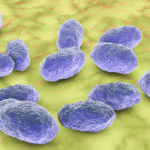Novel Metric Predicts Severity of Community-Acquired Pneumonia
Novel Metric Predicts Severity of Community-Acquired Pneumonia https://pediatricsnationwide.org/wp-content/themes/corpus/images/empty/thumbnail.jpg 150 150 Rachael Hardison Rachael Hardison https://pediatricsnationwide.org/wp-content/uploads/2021/03/Rachael-Hardison-bio.gif- April 19, 2019
- Rachael Hardison
Researchers utilize a biomarker to predict disease severity during early stages of pneumonia.
Community-acquired pneumonia (CAP) is a leading cause of hospitalization and mortality in children. Each year, 4 percent of children under 5 years of age will develop CAP in industrialized countries. Although pneumonia is common, diagnosing and treating it remains a challenge for clinicians – largely due to a number of unknowns associated with the early stages of CAP.
“When a child comes to the emergency room with CAP, we often don’t know what’s causing it. And we can’t predict if that patient is going to get worse and have to go to the intensive care unit or if we can send them home with antibiotics,” says Rebecca Wallihan, MD, an Infectious Diseases specialist at Nationwide Children’s Hospital and assistant professor at The Ohio State College of Medicine. “We know a lot about CAP, but the reality is that we still don’t know enough to be practical.”
To address these unknowns, clinicians need a way to quickly and accurately predict disease severity in children with CAP. Working with Octavio Ramilo, MD, division chief of Infectious Diseases and principal investigator in the Center for Vaccines and Immunity in The Research Institute at Nationwide Children’s, Dr. Wallihan initiated a clinical study to determine if they could use transcriptional profiling to identify better markers of disease severity in children hospitalized with CAP.
Specifically, the researchers used a novel metric called Molecular Distance to Health (MDTH). MDTH is a single numerical score that summarizes the overall change in expression of immune-related genes in a patient compared to a healthy, age-matched control. The researchers collected blood samples from 152 patients hospitalized with CAP and completed transcriptomic analysis to examine gene expression patterns and assign an MDTH score to each patient.
When the researchers compared MDTH to traditional markers of disease severity such as C-reactive protein, procalcitonin and white blood cell counts, they found that MDTH was more significantly associated with disease severity of CAP as measured by the length of hospitalization and duration of fever. These findings were recently published in Frontiers in Cellular and Infection Microbiology.
“Our approach gives us a detailed sense of how the immune system is responding to each case of CAP, and this score directly correlates with the severity of disease,” says Dr. Ramilo. “Looking at the host in addition to the pathogen is a key aspect.”
The ultimate goal is identifying pneumonia-specific biosignatures that could be used to diagnose and manage CAP more effectively than current practices. With funding from the Ohio Children’s Hospitals Association, the researchers expanded the study to six children’s hospitals in Ohio. This provides a large database for the researchers to explore the utility of MDTH as a clinical biomarker for disease severity.
“We are trying to build a database of the knowns, and use that data to reveal the unknowns,” says Dr. Ramilo. “That’s the ongoing effort, and this study has been the first return on an investment that we hope will eventually lead to best outcomes for children with CAP not only in Columbus, but worldwide.”
Citation:
Wallihan RG, Suarez NM, Cohen DM, Marcon M, Moore-Clingenpeel M, Mejias A, Ramilo O. Molecular distance to health transcriptional score and disease severity in children hospitalized with community-acquired pneumonia. Frontiers in Cellular and Infection Microbiology. 2018;8:382.
About the author
Rachael is a PhD candidate in Biomedical Sciences at The Ohio State University and is completing her graduate studies at The Research Institute at Nationwide Children’s Hospital in the Center for Microbial Pathogenesis. She contributes to Pediatrics Nationwide and PediatricsOnline, an online newsletter for specialists.
-
Rachael Hardisonhttps://pediatricsnationwide.org/author/rachael-hardison/
-
Rachael Hardisonhttps://pediatricsnationwide.org/author/rachael-hardison/
-
Rachael Hardisonhttps://pediatricsnationwide.org/author/rachael-hardison/
-
Rachael Hardisonhttps://pediatricsnationwide.org/author/rachael-hardison/
- Posted In:
- In Brief










